TUNNEL ENGINEERING
TUNNEL ENGINEERING
TUNNEL ENGINEERING
You also want an ePaper? Increase the reach of your titles
YUMPU automatically turns print PDFs into web optimized ePapers that Google loves.
20.2 n Section Twenty<br />
Dry Packing. Filling a void with a stiff mortar,<br />
placed in small increments, each rammed into<br />
place.<br />
Evasé Stack. An air-exhaust stack with a cross<br />
section increasing in the direction of air flow at a<br />
rate to regain pressure.<br />
Face. The surface at the head of a tunnel<br />
excavation. A mixed face is a condition with more<br />
than one type of material, such as clay, sand, gravel,<br />
cobbles or rock.<br />
Grommet. A ring of compressible material<br />
inserted under the head and nut of a bolt<br />
connecting tunnel liners to seal the bolt hole.<br />
Heading. A small tunnel, or tunnels, excavated<br />
within a large tunnel cross section which will be<br />
enlarged to the full section.<br />
Jumbo. A frame that rolls on tracks or rubber<br />
wheels and carries drills for excavation of rock<br />
tunnels.<br />
Lagging. Timber planks or steel plates inserted<br />
above tunnel-supporting ribs to hold back rocks<br />
or soil.<br />
Liner Plate. A steel segment to support the<br />
interior of a tunnel excavation.<br />
Lining. A temporary or permanent structure<br />
made of concrete or other materials to secure and<br />
finish the tunnel interior or to support an<br />
excavation<br />
Mucking. Removal of excavated or blasted<br />
material from face of tunnel.<br />
Pilot Tunnel. A small tunnel excavated over part<br />
or the entire length to explore geological conditions<br />
and assist in final excavation.<br />
Pioneer Bore. (See Pilot Tunnel.)<br />
Poling Boards. Timber planks driven into soft<br />
soil, over timber supports, to hold back material<br />
during excavation.<br />
Scaling. Removal of loose rocks from tunnel<br />
surface after blasting.<br />
Shield. A steel cylinder of diameter equal to that<br />
of the tunnel, for excavation of tunnels in soft<br />
material to provide support at the face of the tunnel,<br />
to provide space for erecting supports, and to<br />
protect workers excavating and erecting supports.<br />
Spiling. (See Poling Boards.)<br />
<strong>TUNNEL</strong> <strong>ENGINEERING</strong><br />
20.2 Clearances for Tunnels<br />
Clearance in a tunnel is the least distance between<br />
the inner surfaces of the tunnel necessary to<br />
provide space between the closest approach of<br />
vehicles or their cargo or pedestrian traffic and<br />
those surfaces. Minimum tunnel dimensions are<br />
determined by adding the minimum clearances<br />
established for a tunnel to the dimensions selected<br />
for the type of traffic to be accommodated in the<br />
tunnel and the space needed for other requirements,<br />
such as ventilation ducts and pipelines.<br />
Clearances for Railroad Tunnels n Individual<br />
railroads have different standards to suit<br />
their equipment. But on tangent tracks, clearances<br />
for single- and double-track tunnels should not be<br />
less than those shown in Fig. 20.1. (Clearances<br />
shown are those in the “AREMA Manual”<br />
American Railway Engineering and Maintenanceof-Way<br />
Association, 8201 Corporate Drive, Suite<br />
1125, Landover, MD 20785, (www.AREMA.org).<br />
In rail tunnels, clearances for personnel are<br />
required on both sides where niches are not<br />
provided. These clearances should be at least 6 ft<br />
8 in or 2 m high and 30 in wide each side of the<br />
vehicle clearance diagram, although a 24-in<br />
minimum is permitted on some lines. In highway<br />
tunnels, a 3 ft or 0.9 m clearance from face of curb<br />
is used where walkways are provided. In both<br />
road and rail tunnels, it is common practice to<br />
provide a walkway along the common wall<br />
between adjacent ducts to facilitate emergency<br />
evacuation between ducts and to prevent people<br />
from emerging directly into the path of oncoming<br />
traffic.<br />
On curved tracks, the clearances should be<br />
increased to allow for overhang and tilting of an 85ft-long<br />
car, 60 ft c to c of trucks, and a height of 15 ft<br />
1 in above top of rail. (Distance from top of rails to<br />
top of ties should be taken as 8 in.)<br />
The track should be superelevated at curves<br />
according to AREMA standards.<br />
Clearances for pantograph, third-rail, or catenary<br />
construction should conform to diagrams<br />
published by the Electrical Section, Engineering<br />
Division of the Association of American Railroads.<br />
The latest clearance standards of AREMA<br />
should be checked for new construction. Local<br />
legal requirements should govern if they exceed<br />
these standards.<br />
Downloaded from Digital Engineering Library @ McGraw-Hill (www.digitalengineeringlibrary.com)<br />
Copyright © 2004 The McGraw-Hill Companies. All rights reserved.<br />
Any use is subject to the Terms of Use as given at the website.
















